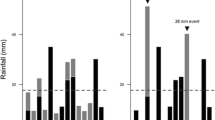Abstract
From 9 March 2016 to 12 November 2018 we conducted an intensive experimental field campaign, the WormEx I Experiment, to quantitatively assess the seasonality of the earthworm macropores and their effect on the soil hydrological properties in a temperate mountain range. Six 1-m2 plots were selected in two shallow soils in Valle Camonica (Central Italian Alps) at an elevation of 274 and 935 m a.s.l., in order to count the earthworm macropores. Two plots were amended with calcium trioxocarbonate to stimulate the digging activity. In this work we present results regarding the seasonality of earthworm macropores, its correlation with the antecedent meteorological conditions and the effectiveness of calcium trioxocarbonate. Earthworm activity showed a marked seasonality with Winter hibernation and medium or great digging activity during all the other seasons. A relevant peak of Summer and Autumn macropores was detected in the site at 935 m a.s.l.. The castings number resulted very well positively correlated to the antecedent air temperature in both sites. It resulted correlated to the antecedent precipitation, with increasing Pearson’s coefficient at increasing time window in the range from 1 day to 8 weeks. Also, it resulted very well positively correlated to the antecedent average soil water content in a range from 1 to 4 days. Finally, the calcium trioxocarbonate proved to be effective at stimulating the earthworm digging activity.





Similar content being viewed by others
REFERENCES
D. L. Bailey, D. W. Held, A. Kalra, N. Twarakavi, and F. Arriaga, “Biopores from mole crickets (Scapteriscus spp.) increase soil hydraulic conductivity and infiltration rates,” Appl. Soil Ecol. 94, 7–14 (2015). https://doi.org/10.1016/j.apsoil.2015.04.011
A. Bandini, “Tipi pluviometrici dominanti sulle regioni italiane,” in Il Servizio Idrografico Italiano (Ministero dei Lavori, Rome, 1931).
S. Barontini, G. Grossi, N. Kouwen, S. Maran, P. Scaroni, and R. Ranzi, “Impacts of climate change scenarios on runoff regimes in the southern Alps,” Hydrol. Earth Syst. Sci. Discuss. 6, 3089–3141 (2009). https://doi.org/10.5194/hessd-6-3089-2009
K. Beven and P. Germann, “Macropores and water flow in soils revisited,” Water Resour. Res. 49, 3071–3092 (2013). https://doi.org/10.1002/wrcr.20156
M. Blouin, M. E. Hodson, E. A. Delgado, G. Baker, L. Brussaard, K. R. Butt, J. Dai, L. Dendooven, G. Peres, J. E. Tondoh, D. Cluzeau, and J. J. Brun, “A review of earthworm impact on soil function and ecosystem services,” Eur. J. Soil Sci. 64, 161–182 (2013). https://doi.org/10.1111/ejss.12025
L. Chinaglia, “Materiali per la fauna della provincia di Brescia. Alcuni lombrichi raccolti nel bresciano,” Comment. Ateneo Brescia 1910, 108–118 (1911). https://www.ateneo.brescia.it/controlpanel/uploads/commentari-1908-2008/CAB1910.pdf.
C. Darwin, The Formation of Vegetable Mould Through the Action of Worms, with Observations on Their Habits (John Murray, London, 1881).
O. Graff, “Stickstoff, Phosphor und Kalium in der Regenwurmlosung auf der Wiesenversuchsfläche des Sollingprojektes,” Ann. Zool. Ecol. Anim. 4, 503–512 (1971).
R. Graham, “Factors of soil formation: topography,” in Soils: Basic Concepts and Future Challenges, Ed. by G. Certini and R. Scalenghe (Cambridge University Press, Cambridge, 2006), pp. 151–163. https://doi.org/10.1017/CBO9780511535802.012
T. Haraldsen, M. Larsen, and K. Myhr, “Effects of cattle slurry and soil compaction on the earthworm population in a silty clay loam soil in central Norway,” Norw. J. Agric. Sci. 8, 231–241 (1994).
D. Johnson and D. Watson-Stegner, “Evolution model of pedogenesis,” Soil Sci. 143, 349–366 (1987). https://doi.org/10.1097/00010694-198705000-00005
F. Kollmannsperger, “Lumbriciden in humiden und ariden gebieten und ihre bedeutung für die fruchtbarkeit des bodens,” in Proceedings of the VI Congr. International de la Science du Sol, Paris (International Society of Soil Science, Vienna, 1956), pp. 293–297.
A. Kretzschmar, “Ecological quantification of burrow systems of earthworms—Techniques and first estimations,” Pedobiologia 18, 31–38 (1978).
A. Kretzschmar, “The burrow system of earthworms in grassland—Seasonal variations of field observations,” Rev. Ecol. Biol. Soil 19, 579–591 (1982).
P. Lavelle, PhD Thesis (École Normale Supérieure, Paris, 1978).
P. Lavelle, “Earthworm activities and the soil system,” Biol. Fertil. Soils 6, 237–251 (1988). 3https://doi.org/10.1007/BF00260820
Y. Nakamura, “Studies on the ecology of terrestrial Oligochaetae. I. Seasonal variation in the population density of earthworms in alluvial soil grassland in Sapporo, Hokkaido,” Appl. Entomol. Zool. 3, 89–95 (1968). https://doi.org/10.1303/aez.3.89
A. Negm, M. Falocchi, S. Barontini, B. Bacchi, and R. Ranzi, “Assessment of the water balance in an Alpine climate: setup of a micrometeorological station and preliminary results,” Procedia Environ. Sci. 19, 275–284 (2013). https://doi.org/10.1016/j.proenv.2013.06.032
P. Omodeo, “Il letargo nei Lombrichi,” Ital. J. Zool. 15, 11–18 (1948). https://doi.org/10.1080/11250004809440053
G. Pérès, PhD Thesis, (Université Rennes, Rennes, 2003).
G. Pérès, A. Bellido, P. Curmi, P. Marmonier, and D. Cluzeau, “Relationships between earthworm communities and burrow numbers under different land use systems,” Pedobiologia 54, 37–44 (2010). https://doi.org/10.1016/j.pedobi.2010.08.006
A. V. Smagin and A. V. Prusak, “The effect of earthworm coprolites on the soil water retention curve,” Eurasian Soil Sci. 41, 618–622 (2008). https://doi.org/10.1134/S1064229308060069
T. Sveistrup, T. Haraldsen, and F. Engelstad, “Earthworm channels in cultivated clayey and loamy Norwegian soils,” Soil Tillage Res. 43, 251–262 (1997). https://doi.org/10.1016/S0167-1987(97)00019-6
L. van Schaik, J. Palm, J. Klaus, E. Zehe, and B. Schröder, “Linking spatial earthworm distribution to macropore numbers and hydrological effectiveness,” Echohydrology 7, 401–408 (2013). https://doi.org/10.1002/eco.1358
J. G. Zaller and J. A. Arnone III, “Activity of surface—casting earthworms in a calcareous grassland under elevated atmospheric CO2,” Oecologia 111, 249–254 (1997). https://doi.org/10.1007/pl00008817
Y. Zhang, M. Zhang, J. Niu, and H. Zheng, “The preferential flow of soil: a widespread phenomenon in pedological perspectives,” Eurasian Soil Sci. 49, 661–672 (2016). https://doi.org/10.1134/S1064229316060120
Author information
Authors and Affiliations
Corresponding author
Ethics declarations
The authors declare that they have no conflicts of interest.
Supplementary Information
Rights and permissions
About this article
Cite this article
Pezzotti, D., Peli, M., Sanzeni, A. et al. Seasonality of Earthworm Macropores in a Temperate Alpine Area. Eurasian Soil Sc. 54, 1935–1944 (2021). https://doi.org/10.1134/S1064229321130032
Received:
Revised:
Accepted:
Published:
Issue Date:
DOI: https://doi.org/10.1134/S1064229321130032




